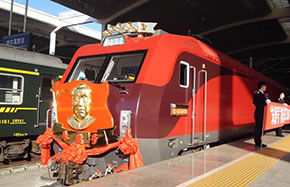Low iron ore prices cause angst
Big drop has caught many unawares in China, but there are reasons for longer-term optimism
Iron ore, the raw material for steel, rose about 25 percent in price during the course of April after hitting eight-year lows. But there is no guarantee the trajectory will remain upward.
That will bring little comfort to mining companies around the world forced to close their high-cost operations, inflicting a huge human cost with thousands of workers, including those in support functions and industries, laid off.

This is a pain felt in China where many iron ore mines - typically small-scale operations producing expensive, low-grade ore - have stopped producing. One estimate put it at 40 percent.
The China Iron and Steel Association said more than half of the country's iron ore mines produce at a cash cost of at least 500 yuan ($81; 72 euros) a metric ton, but the raw material has not sold at that price on the international markets since October. With large-scale global miners producing at well below $35 a ton, it is easy to see why high-cost Chinese mines are being mothballed.
A consequence is that imported ore is taking a bigger share of Chinese consumption, up 9.7 percentage points to 78.5 percent of all ore consumed last year, according to the association. Last year also saw China import a record 933 million tons of iron ore, up 13.8 percent on 2013. If domestic mine shutdowns continue, the association said it fears imports could end the year meeting more than 80 percent of China's iron ore demand.
Not that Beijing has been sitting idly by while one of the country's resource industries suffers. It reduced taxes on iron ore by 60 percent on May 1, which should ease the strain on domestic producers. The previous tax rate on iron ore operations came to 30 percent, much higher than the level in other countries, which is usually between 4 and 10 percent, according to the association.
The association wants to see the central government accelerate tax relief measures. "We're not on a level playing field with global miners," Executive Vice-Chairman Zhu Jimin was recently quoted as saying. "We need to lessen the burden on our iron ore mines. We need a batch of mines that can survive even when the global price of iron ore falls to $60 a ton."
Some market observers, such as global rating agency Fitch, are prepared to give the government credit by saying the measures should ensure fewer iron ore mine closures this year and provide a lifeline to keep domestic supply in the market longer.
Iron ore's nadir was reached on April 2 when the benchmark spot price closed at $46.70 a ton. It regained about 25 percent by the end of the month at just below $60. While the decline from around $133 a ton at the start of 2014 was largely steady and plain for all to see, the depth and severity seem to have caught experienced mining executives by surprise.
Gina Rinehart, chairman of Australia's Hancock Prospecting, told a mining industry lunch in Sydney: "None of us predicted it would be as bad as this. Nobody was predicting, even the most conservative ones, the ore price crash. The ore price could be down for quite some time. Will it be down forever? Of course not."
Her company is due to start producing from its $10 billion Roy Hill mine in Western Australia in September, adding 55 million tons a year to a market already groaning under a surplus. Many would see that as adding to the problem, especially when analysts project about 300 million tons a year of extra iron ore will enter the global market by 2017. Investment bank Morgan Stanley forecasts an excess of 55 million tons this year, rising to 184 million tons by 2018.
A portion of that surplus is down to the massive expansions carried out by the Big Four of BHP Billiton, Rio Tinto and Fortescue Metals Group in Australia, and Vale in Brazil, plus new mine developments from the likes of Hancock Prospecting (Roy Hill) and Anglo American's Minas-Rio mine in Brazil, which is scheduled to reach its 26.5 million tons a year capacity in about a year's time.
In late April, BHP Billiton announced a slowdown in its Australian expansion plans. It will increase from the current run rate of 250 million tons to 270 million tons a year as scheduled, but is deferring a project to increase throughput at its main export port. "While this will lead to a slower path to system capacity of 290 million tons a year, it will come at a lower capital cost," it said.
The announcement proved to be the spark to ignite a rally in iron ore, which like all volatile commodities has a price that yo-yos. So, is iron ore going to surrender its recent gains? While many market observers feel that the bullish sentiment seen of late has been overdone and the market is heading for a correction (code for lower prices), longer term there are reasons to be optimistic.
It is true that the major producer and consumer, China, will require less steel in one key area because it is cutting back on new tower blocks, railways, roads and other steel-consuming infrastructure projects at home. But market commentators are quick to point out that the Chinese leadership's drive to make the country a more consumer-oriented economy means the extra cars, washing machines and many other goods produced will require steel.
Then there's China's lead in forming the new Asian Infrastructure Investment Bank to develop sectors such as energy, transportation, telecommunications, agricultural and environmental protection across Asia. More steel, and therefore iron ore, will be needed.
In addition, the Indian government has a policy to take the country's steel-making capacity up to 300 million tons a year by 2025, up from around 100 million tons a year at present. A consensus is forming among market observers that the former third-placed iron ore exporter is likely to become an iron ore importer to meet the needs of its steel mills, especially when one factors in the bureaucratic and, in some cases, court-ordered restrictions on iron ore mining in India.
So, while a growing surplus supply suggests the glass is half empty for those in the iron ore industry, the number of areas for potentially increased demand point toward it being half full.
The author is managing director of SG Editorial Services. The views do not necessarily reflect those of China Daily.


















